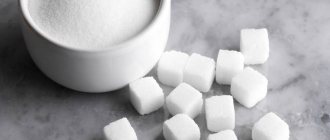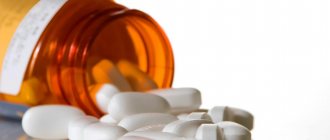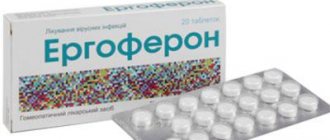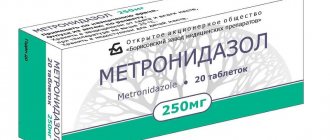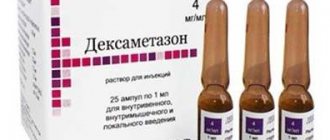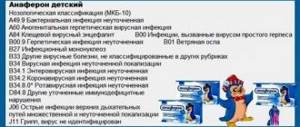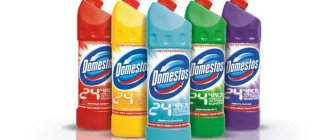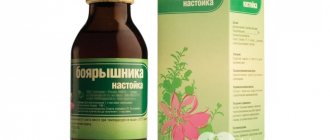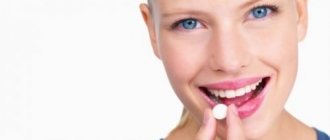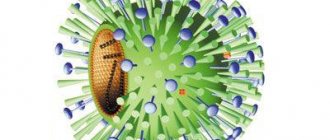Category: Drug poisoning
Nazivin is a liquid solution that contains oxymetazoline. The substance exhibits a vasoconstrictor and decongestant effect, eliminates nasal congestion, making breathing easier.
When used as directed, the medicine does not enter the bloodstream and, therefore, does not have a systemic effect.
An overdose of Nazivin occurs as a result of violating the rules of administration, exceeding the therapeutic dose, or accidentally ingesting liquid.
Reasons why poisoning may occur
Naphthyzin, like any other drug, can cause harm to the body. Symptoms can appear not only with long-term use, but also with one-time use of drops. So, let's figure out why seemingly ordinary drops can cause serious poisoning.
- Vasoconstrictor drops called Naphthyzin are available in plastic bottles. It is not always possible to give the child the required number of drops by pressing on the bottle; in this case, the dose may increase several times.
- Parents very often confuse the adult dosage of 0.1% with the children's dosage of 0.05%.
- Very often there is non-compliance with the rules for using a medicinal product. The instructions indicate that the drops should not be used by children under one year of age, and young mothers use the drug on their own, which risks causing serious harm to the health of the baby.
- Naphthyzin is an effective, inexpensive drug that is extremely popular. For children, its use can have dire consequences.
Poisoning with naphthyzine drops in children is not uncommon
Therapeutic doses
There is a special dosage for children depending on age:
- under 1 year, starting from 5 weeks - 0.01% solution, a few drops 2 - 3 times a day;
- from 1 to 6 years - 0.025% 1 - 2 drops 2 - 3 r. per day;
- over 6 - 0.05% according to a similar scheme.
Adults are prescribed the same dosage (0.05% solution) or 1 to 2 intranasal injections several times a day.
The duration of the treatment course is determined by the therapist, based on the severity of the condition, the characteristics of the disease, on an individual basis. Treatment, as a rule, lasts no more than 7 days, since then the intensity of the therapeutic effect decreases.
First symptoms
Naphthyzine poisoning in children is quite common. In order to determine whether the child has actually been poisoned, it is necessary to monitor his condition. The first symptoms that you might be concerned about are:
- pronounced weakness and lethargy in the baby;
- mood swings, tearfulness;
- cramping pain in the head and slight dizziness;
- nausea turning into vomiting;
- decrease in temperature;
- bradycardia;
- hypotension (low blood pressure);
- complete refusal of food;
- drowsiness;
- pale skin (skin becomes damp and cold);
- slight constriction of the pupils.
When the first such symptoms are detected, it is necessary to urgently call a qualified medical specialist who will provide the necessary assistance and eliminate the symptoms of overdose. It is strictly forbidden to carry out treatment at home!
Interaction with other medications
The simultaneous use of Nazivin with drugs that have a hypertensive effect on the vascular system is not recommended. These include:
- monoamine oxidase inhibitors (MAOIs);
- tricyclic antidepressants.
A vasoconstrictor pharmaceutical reduces the rate of absorption of local anesthetics (Lidocaine).
Combination with drugs that have similar pharmacological properties increases the likelihood of an overdose of Nazivin and the development of pronounced adverse reactions.
Treatment for poisoning
First of all, treatment should be aimed at eliminating the symptoms of naphthysine poisoning. Upon arrival of the emergency doctor, it is necessary to tell how the drug was taken and in what dosage. If a mild form of poisoning occurs, the baby will be given first aid on the spot and given further recommendations for treatment. In severe cases, they are transported to the hospital and treated in a hospital setting.
It often happens that children independently use medications for medical purposes. To prevent this from happening, parents should be careful about the storage of all medications, that is, keep them out of the reach of children.
Indications for use
The use of Nazivin is advisable for the following pathologies:
- acute respiratory infections, acute respiratory viral infections, accompanied by a runny nose;
- allergic rhinitis;
- vasomotor rhinitis;
- sinusitis.
The drug is also prescribed to prepare the nasal mucosa (eliminate swelling) before diagnostic studies.
Note for young parents
- The drug should not be used by infants.
- Drops should be prescribed by a pediatrician in accordance with the dosage according to the child’s age.
- Increasing the dose does not increase the effect of the drug, but increases the risk of severe poisoning.
- The recommended dose for a child should not exceed 1-2 drops of a 0.05% Naphthyzin solution.
- Correct use of the drug will clear the child's airways and make nasal breathing easier.
- Due to the fact that the drug is addictive, drops can be used no more than once with an interval of 6-7 hours.
- It is effective to use a pipette to accurately measure a drop. This way you can see the amount of the drug collected.
- In order not to cause addiction in the child, it is necessary to alternate naphthyzin with other drops intended for the treatment of colds in children.
Most people are accustomed to using vasoconstrictor nasal drops at the slightest manifestation of a runny nose in a child or adult. At the same time, there are ardent opponents of these drugs who refuse to treat a runny nose with them. Who is right? Indeed, uncontrolled spraying of vasoconstrictor sprays into the nose can lead to serious consequences in adults and children. In this article, we looked at the reasons why an overdose of vasoconstrictor drops may develop, the symptoms and methods of treating this condition.
What dosage is considered safe?
Naphthyzin is suitable only for topical use in case of severe swelling and hyperemia of the nasal mucosa. It can be used in adult patients for no longer than 5-7 days. For children, the maximum duration of therapy is 3 days (in exceptional cases, this period can be increased to 5 days).
The dosage depends on the age of the patient and is usually:
- children under 12 years old – 1-2 drops 3 times a day;
- adults and adolescents over 12 years old – 3 drops 3-4 times a day.
The drug is not prescribed to children under 1 year of age.
Important! The lethal dose of Naphthyzin for an adult is 10-15 ml. This is approximately 1 bottle of the drug. In childhood, the lethal and sublethal rate is almost 2 times lower and amounts to 5-7.5 ml.
In what cases are vasoconstrictor nasal drops used?
Vasoconstrictor drops or sprays are prescribed to treat certain diseases of the nose and ears. Just like that, for any runny nose, you shouldn’t use them
neither in children nor in adults.
They are available in the form of drops or spray. They need to be instilled into both nostrils. The dosage, frequency and duration of treatment are discussed with the treating doctor.
Remember that a therapist or otolaryngologist should prescribe vasoconstrictor drugs. It is very dangerous to use them on your own; they can cause the development of chronic rhinitis, atrophy of the nasal mucosa, or drug poisoning.
Indications for the use of vasoconstrictor nasal drops:
- Otitis media is an inflammation of the middle parts of the ear. Drops accelerate the removal of inflammation and swelling from the internal structures of the ear;
- Eustachitis is an inflammation of the auditory Eustachian tube, in which the flow of air into the structures of the middle ear is disrupted. This disease is almost always accompanied by severe hearing loss. Vasoconstrictor medications relieve swelling and relieve ear congestion
. - Difficulty in nasal breathing due to inflammatory bacterial or viral diseases accompanied by a runny nose.
Briefly about Naphthyzin
Naphthyzin is a vasoconstrictor medicine in the form of an aqueous solution, which is used for the symptomatic treatment of acute rhinitis and to facilitate nasal breathing with severe swelling of the nasal mucosa. The drug is available in the form of nasal drops and spray and, according to its pharmacological properties, belongs to the group of adrenergic agonists and anticongestants. The active ingredient in the drug is naphazoline, a crystalline powder of white or yellow-white color to constrict blood vessels.
With frequent use, Naphthyzin can cause not only physical, but also psychological dependence, as well as a special type of runny nose, which is an independent nosological unit - medicinal rhinitis. The content of naphazoline in 1 ml of the drug is 1 mg - this is a safe therapeutic dose, which, with short-term use, does not cause dependence and does not have any significant side effects on the patient’s body.
Indications for the appointment of Naphthyzin are:
- laryngitis - inflammation of the mucosal membranes lining the surface of the larynx with primary damage to the vocal cords;
- damage to the Eustachian tube;
- all types of sinusitis (inflammatory processes in the paranasal sinuses);
- acute rhinitis (as an adjuvant to relieve symptoms).
In some cases, a one-time use of the drug is indicated if it is necessary to examine the nasal cavity using a rhinoscope.
Causes of poisoning with vasoconstrictor drops
Intoxication with these drugs most often develops as a result of their improper and independent use. Exceeding the dosage of vasoconstrictor drops is very dangerous
and can lead to disruption of the entire body.
The causes of poisoning with vasoconstrictor drops are listed below:
- Frequent nasal drops to improve nasal breathing. Sometimes, during acute viral processes, it is not possible to completely decompress the nose, and free breathing does not return after instilling a dose of the drug. But this does not mean that it is necessary to re-inject the medicine.
- Incorrect dosage selection. For example, an adult dose of a vasoconstrictor drug is toxic to a child and can cause acute poisoning.
- Parallel use of several different vasoconstrictor drugs. At the same time during treatment, you can use only one nasal spray from the drug group. Combining several different drops with a similar effect or with the same active ingredient leads to the development of an overdose.
- Accidental ingestion of nasal drops can occur in a child who finds the drug. All medications should be kept out of the reach of children.
With prolonged use of vasoconstrictor nasal drops in normal dosages, chronic rhinitis develops. People become dependent on a bottle of vasoconstrictor drops and carry it with them all the time.
Examples of drugs
In pharmacies you can find a large variety of vasoconstrictor drops and sprays. They all have a similar effect, but may differ from each other in dosage rules and active substance . Examples of drugs:
- "Rinazolin";
- "Naphthyzin";
- "Otrivin";
- "Nazol";
- "Nesopin";
- "Lazolvan Rino."
Overdose symptoms
The severity of intoxication directly depends on the amount of the drug injected into the nose. The larger it is, the worse the patient’s condition. Signs of intoxication appear within the first hour after the drug enters the body
.
Vasoconstrictor drops in large dosages have a direct effect on the functioning of the cardiovascular and nervous systems. Symptoms of an overdose of these drugs are listed below:
- Constriction of the eye pupils, they become like a small dot. In this case, the pupils practically do not react to changes in light.
- Severe dryness in the nose. Nosebleeds may develop.
- Heart rhythm disturbance. With mild intoxication, tachycardia is observed - rapid heartbeat. Severe poisoning is accompanied by the development of bradycardia - slowing of the pulse
. - Changes in blood pressure levels. Depending on the severity of the patient's condition, it may decrease or increase.
- Pale and blue discoloration of the skin develops due to hypoxia and insufficient blood supply.
- Nausea and vomiting that does not bring relief. These symptoms develop due to hypoxia and damage to the central nervous system.
- Drowsiness and lethargy. The person feels dizzy and very weak. A headache may develop.
- Slow breathing.
- Hypothermia is a decrease in body temperature below 36 degrees.
- Impaired consciousness, up to the development of a deep coma.
Common Adverse Reactions
Nazivin is well tolerated, with the exception of rare cases when patients noted a burning sensation and drying of the nasal mucosa, which was mainly associated with an overdose.
Side effects include:
- reactive hyperemia;
- itching in the nasal cavity;
- frequent sneezing;
- feeling of tightness in the bridge of the nose.
Rarely observed:
- frontal headache;
- increased heart rate;
- increased blood pressure;
- prostration;
- sleep disturbance.
If such symptoms appear, use of the drug should be suspended until the true causes of deterioration in well-being are determined.
First aid and treatment for overdose
What to do in case of acute poisoning with vasoconstrictor drops? The first thing you should do is call an ambulance
. Briefly tell the dispatcher about what happened by phone and give the exact address.
If a person takes nasal drops, the stomach should be rinsed immediately. To do this, the patient needs to drink several glasses of water in one gulp and induce vomiting. Then you should drink some kind of sorbent, for example, activated carbon.
If an overdose has developed as a result of excessive instillation of the drug into the nose, rinsing the stomach or drinking sorbents is pointless. Before the doctors arrive, try to calm the patient down; you can give him plain water or sweet, weak black tea.
First aid will be provided to the patient by the doctors who arrive on call. They will conduct a quick examination of the patient and administer the necessary medications to stabilize the cardiovascular system and breathing.
In case of poisoning with vasoconstrictor drops, hospitalize the patient in a toxicology or intensive care unit. There is no specific antidote
. All treatment is aimed at eliminating symptoms, removing the drug from the body and regulating heart function.
Vasoconstrictor nasal drops help treat acute inflammatory diseases of the nose and ears. They help restore breathing when the nasal passages are congested. Before using these medications, you should consult your doctor. In large dosages, they can cause severe poisoning, accompanied by disruption of the heart and breathing. When the first signs of an overdose appear, you should call an ambulance. Treatment of this condition is carried out in a hospital setting.
Any home medicine cabinet will probably contain vasoconstrictor nasal drops. It would seem that these are harmless remedies that quickly relieve nasal congestion during a runny nose. But in Australia they are prohibited for use by children under 2 years old, in the UK - up to 6 years old, and in some places in Italy - even up to 12 years old. They are also recommended to be used with caution during pregnancy. The reason is that they are dangerous for young patients!
What threat do vasoconstrictor nasal drops pose to children?
Nasal drops that quickly relieve swelling and restore nasal breathing contain a drug from the group of so-called alpha-2 adrenergic agonists. They constrict the blood vessels of the mucous membrane of the nasal passages and reduce the production of inflammatory serous or mucous secretions. But these substances are easily absorbed into the blood. And then, along with the desired local effect, their pronounced side effect on the entire cardiovascular system appears. The worst thing is that they affect the brain in such a way that they reduce blood pressure until the development of hypotonic shock. Think about it: simply putting drops into your nose can cause severe poisoning!
Possible consequences
In mild cases of Naphthyzin overdose, all symptoms disappear within 24 hours, provided that further use of the drug is discontinued.
The consequences of severe intoxication can be:
- pneumonia due to breathing problems;
- a sharp increase in blood pressure, dangerous for older people (the prospect of developing a stroke or myocardial infarction).
Video from YouTube on the topic of the article:
A runny nose in children is often a manifestation of a respiratory viral disease, and parents want to rid their child of this illness as soon as possible. But be careful, some nasal drops can cause serious complications in children, especially if the instructions are not followed.
It can manifest itself as abundant mucus secretion from the nasal passages, as well as nasal congestion. And in children of the first years of life, in any case, a runny nose leads to sleep disturbances and difficulty eating. Therefore, very often vasoconstrictor nasal drops are used to treat rhinitis. Such drops contain special substances - alpha2-adrenergic agonists, which constrict the vessels of the nasal mucosa, and thereby temporarily reduce swelling and the amount of discharge. Such drugs are easy to buy at a regular pharmacy, and they are almost always available in your home medicine cabinet. Adults often use them on children without a doctor's prescription. But not everyone knows about the complications that arise from such drugs.
How does hypotonic shock manifest in children?
A stuffy nose causes a lot of trouble for a child. He cannot breathe normally, and therefore is capricious during meals and games, during daytime sleep, and often wakes up crying at night. It would seem that there is nothing unusual in the fact that after an adrenergic agonist is instilled into the nose, the baby stops snoring and quickly falls asleep. Therefore, the first signs of low blood pressure are drowsiness and lethargy.
- in case of poisoning, as a rule, parents skip it. According to statistics, the most common complaint when seeking help is “the child does not wake up” or “it was difficult to wake up, but falls asleep again.”
The greater the number of vasoconstrictor drops in the nose that are absorbed into the systemic bloodstream, the more pronounced will be the general pallor of the skin, blueness around the mouth, sweating, and coldness of the extremities. In children, breathing becomes rare and barely noticeable to the eye, as if they are not breathing at all. The body is relaxed, any movement is difficult for them. In severe cases, an epileptic seizure or cerebral coma may develop.
Prevention measures
To avoid drug overdose, you must adhere to the following rules:
- Follow the dosage that should ideally be prescribed by a doctor for an adult or child. During the examination, he will adequately assess the patient’s health condition and prescribe a method and time of admission. When self-medicating, it is important not to exceed the doses recommended by the instructions. The opinion that the more the drug enters the body, the sooner it will become easier, is erroneous.
- Do not leave the drug unattended and store it out of the reach of children.
- Do not allow drops to get into your eyes.
- When purchasing a medicine, check that the expiration date has not expired.
The human body is individual, and sometimes intolerance to any component of the drug may become known only when taking it for the first time. Allergies, including those due to a weakened immune system, can manifest themselves in the form of a rash or Quincke's edema. Therefore, you should be prepared for allergic reactions and always keep antihistamines at home to relieve the first symptoms.
When nasal drops cause poisoning in a child
The main reason is an overdose of the drug. When this happens:
- a solution containing a higher concentration of adrenergic agonists is used than is permitted at a certain age. ;
- . For example, after instilling drops from the nose, mucus is removed and the medicinal spray is immediately reused;
Accidental poisonings also occur in children when a bottle of spray is left within reach and the child drinks the medicine
. Even one sip of an adrenergic agonist, especially on an empty stomach, is enough to cause severe poisoning to develop.
How to protect your baby from dangerous nasal drops
The basic rule is to comply with the requirements for age, quantity and frequency of use of the drug specified in the annotation for the drug. Try not to buy sprays containing naphazoline, xylometazoline and oxymetazoline at the pharmacy. Remember that vasoconstrictor drops do not treat a runny nose, but only facilitate nasal breathing when the mucous membrane is swollen. This is usually observed in the first 1-3 days of a viral infection. Before instilling an adrenergic agonist, you need to clear the nasal passages of mucus using a saline solution or sea water and a suction bulb. Perhaps this procedure will be enough to make the child’s nose “breathe.”
According to Life, well-known pharmaceutical companies and Roszdravnadzor bombarded Russian pediatricians with warnings in 2016–2017. Their content is approximately the same: children are increasingly being poisoned by vasoconstrictor drops. We are talking about naphthyzin, sanorin, otrivin and other similar drugs. If you overdo it with treatment, the child may get heart problems or even fall into a coma. As Roszdravnadzor notes, many parents do not know this and therefore allow their children to bury them uncontrollably. As a result, thousands of children across the country end up in hospitals every year.
At the beginning of 2017, one-year-old Seryozha from the city of Tchaikovsky, Perm Territory, caught a cold, and his mother, leaving for work, instructed his grandmother how to treat the baby. And although the boy sniffed, his mother did not leave any drops. The grandmother decided that this was not a problem and gave her grandson naphthyzin. She didn’t even drip it, but, one might say, poured it in, so as not to give the snot a chance. That day Vanya fell asleep earlier than usual after lunch.
Grandma woke him up and dropped more drops. After which the child slept all day.
The mother, returning from work, could not wake up her son. In a panic, she called an ambulance. The arriving team tried in every possible way to bring the child to his senses. With a normal heart rate of about 110–120 beats per minute, Serezha’s heart beat at a speed of only 30 beats. The boy was pale and reacted only to strong painful stimuli. At the hospital they said: naphthyzine poisoning.
The doctors managed to save Seryozha, a day later he was already running around the department, and four days later he was discharged home. The fact that the boy almost died was not the fault of the drops, but of the adults who used them incorrectly.
How the drops work
During flu and colds, our nose becomes blocked because the mucous membrane in the nasal sinuses swells and “swells.” To relieve swelling, millions of our compatriots use naphthyzine-type drops. They constrict the vessels of the mucous membrane, the swelling subsides, and the nasal passages expand.
Sanorin, naphthyzin, xylene, rhinostop are drugs of the same pharmacological group,” explains pediatrician, candidate of medical sciences Tuyara Zakharova.
The problem is that with an overdose, not only the capillaries in the nose begin to narrow. The effect extends to large vessels carrying blood to the kidneys, heart and brain. This is fraught with dangerous consequences: a person’s pulse drops, blood pressure rises, and signs of anemia appear. The adult body is able to “swallow” large doses of drops without serious consequences. But for children, an overdose is extremely dangerous. The worst thing that can happen is heart problems.
For example, sanorin is used only from the age of two, says Tuyara Zakharova. “This is due to the fact that in young children, even a small amount of the drug can cause a spasm in the heart muscle.
Drug poisoning
Roszdravnadzor sounded the alarm and from June 2016 to May 2017 sent 12 official letters to all regional medical institutions about the dangers of using vasoconstrictors. Life has copies of them at its disposal. These documents are ordered to be distributed in all pharmacies and among pediatricians. The letters mention nine names of drops. This is almost the entire “vasoconstrictor” range of Russian pharmacies.
Analyzing information about the side effects [of vasoconstrictor drops and sprays], Roszdravnadzor specialists learned about a significant number of overdoses in pediatric practice, the department’s documents say. — We have recorded a large number of acute and subacute drug poisonings in children under 15 years of age [after using the drugs].
A source in the department told Life that they began to study the problem after reports from children's hospitals in the central region.
We received data from one of the children's hospitals. In their toxicology department, over two years, 892 children under the age of 15 were treated due to [vasoconstrictor] poisonings,” a source told Life. — All poisonings were accidental and occurred due to excess dosages, as well as due to non-compliance with age-related contraindications. However, the documents do not indicate how many children in Russia were poisoned by the drops.
Life sent a request to Roszdravnadzor asking for statistics, but has not yet received a response. The scale of the problem can be assessed using the example of a specific Moscow hospital. Every year, due to improper treatment, only the hospital named after. N.F. Filatova receives 250–300 children under the age of four years.
In 2020, 244 children came to us, and in 2020, 250 children were treated. Basically, in cases of poisoning, all liquid-type medications and even household chemicals are recorded. For example, these are vasoconstrictor nasal drops,” Dmitry Dolginov, head of the hospital’s toxicology department, told Life.
Parents can recognize vasoconstrictor poisoning by several basic signs.
The main sign of vasoconstrictor poisoning is changes in the nervous system. The child becomes restless or, on the contrary, inhibited,” Boris Blokhin, chief freelance pediatrician of the Moscow Department of Health, told Life. — Poisoning can be avoided if you strictly follow the recommendations written on the drugs. And understand that any medicine is not only a treatment for the child, but also the possible development of side effects.
Life sent requests to large pharmaceutical companies in Russia and Germany that produce the drops, asking them to comment on the situation. These are Moscow Endocrine and Merkle GmbH. At the time of publication, only representatives of the company, which produces Nazol drops, responded.
To ensure the correct use of drops, Bayer informed doctors and pharmacists about strict adherence to the dosage regimen, contraindications and precautions when using medications, company representative Svetlana Meleshko told Life. — Bayer carefully processes all information on cases of drug misuse, adverse events and overdoses and provides this information to regulatory authorities.
